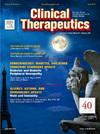Correlation Between Vitamin D, Inflammatory Markers, and T Lymphocytes With the Severity of Chronic Obstructive Pulmonary Disease and its Effect on the Risk of Acute Exacerbation: A Single Cross-sectional Study
IF 3.2
4区 医学
Q2 PHARMACOLOGY & PHARMACY
引用次数: 0
Abstract
Purpose
Chronic obstructive pulmonary disease (COPD) will become the fourth largest cause of death of chronic diseases in the world in 2030. The incidence of COPD ranked top among chronic diseases in the world. At present, there is a lack of simple and effective drugs for the treatment of COPD and for slowing the progression of the disease. The application of vitamin D as a drug in clinical treatment has been a research hotspot. In this study, we investigated the correlation between serum 25-hydroxyvitamin D (25(OH)D), inflammatory markers, and T lymphocytes with the severity of COPD and its effect on the risk of acute exacerbation.
Methods
In this study, we recruited hospital inpatients and outpatient clinic patients with COPD. Their levels of 25(OH)D, inflammatory markers, and T lymphocytes were assessed. We built a nomogram model to evaluate the risk of acute exacerbation of COPD.
Findings
The inflammatory mediators were higher in patients with acute exacerbation of COPD (AECOPD) than those in patients with COPD, but 25(OH)D showed the opposite phenomenon. In logistic regression analysis, high levels of neutrophil-lymphocyte ratio, C-reactive protein, and partial pressure of carbon dioxide and low levels of vitamin D, partial pressure of oxygen, and forced expiratory volume in the first as a percentage of predicted were regarded as independent risk factors for AECOPD. These variables were used for the construction of the nomogram model. The AUCs of the model were 0.971 (95% CI, 0.952–0.989), and 0.981 (95% CI, 0.959–1.000) in the training and testing set respectively, demonstrating that the model exhibited high accuracy for the prediction of the risk of acute exacerbation of COPD. The calibration curve of the nomogram found a high degree of consistency between the expected and actual values. The decision curve analysis and clinical impact curve indicated that the nomogram has clinical applicable for patients with COPD.
Implications
A considerable percentage of patients with COPD were found to have insufficient vitamin D levels. Patients with AECOPD reported more symptoms than those with COPD. The variables neutrophil-lymphocyte ratio, C-reactive protein, partial pressure of carbon dioxide, 25(OH)D, partial pressure of oxygen, and forced expiratory volume in the first as a percentage of predicted can be used for the prediction of AECOPD. Accordingly, this study provided experimental rationales for the role of 25(OH)D in the prevention and the potential anti-inflammatory mechanisms involved in the control of the COPD process.
维生素 D、炎症标志物和 T 淋巴细胞与慢性阻塞性肺病严重程度的相关性及其对急性加重风险的影响:一项横断面研究
目的:到 2030 年,慢性阻塞性肺疾病(COPD)将成为全球第四大慢性病死因。慢性阻塞性肺病的发病率居世界慢性病之首。目前,治疗慢性阻塞性肺病和延缓病情发展的药物缺乏简单有效的药物。将维生素 D 作为药物应用于临床治疗一直是研究热点。本研究探讨了血清 25- 羟维生素 D(25(OH)D)、炎症标志物和 T 淋巴细胞与慢性阻塞性肺疾病严重程度的相关性及其对急性加重风险的影响:在这项研究中,我们招募了慢性阻塞性肺病的住院病人和门诊病人。评估了他们的 25(OH)D 水平、炎症指标和 T 淋巴细胞。我们建立了一个提名图模型来评估慢性阻塞性肺病急性加重的风险:结果:慢性阻塞性肺病急性加重(AECOPD)患者的炎症介质高于慢性阻塞性肺病患者,但 25(OH)D 却显示出相反的现象。在逻辑回归分析中,高水平的中性粒细胞-淋巴细胞比率、C 反应蛋白和二氧化碳分压,以及低水平的维生素 D、氧分压和第一次用力呼气容积占预测值的百分比被视为 AECOPD 的独立风险因素。这些变量被用于构建提名图模型。在训练集和测试集中,模型的AUC分别为0.971(95% CI,0.952-0.989)和0.981(95% CI,0.959-1.000),表明该模型在预测慢性阻塞性肺病急性加重风险方面具有很高的准确性。提名图的校准曲线发现,预期值与实际值高度一致。决策曲线分析和临床影响曲线表明,该提名图适用于慢性阻塞性肺病患者:意义:研究发现,相当一部分慢性阻塞性肺病患者的维生素 D 水平不足。与慢性阻塞性肺病患者相比,AECOPD 患者报告的症状更多。中性粒细胞-淋巴细胞比率、C 反应蛋白、二氧化碳分压、25(OH)D、氧分压和第一次用力呼气量占预测值的百分比等变量可用于预测 AECOPD。因此,本研究为 25(OH)D 在预防慢性阻塞性肺病过程中的作用和潜在的抗炎机制提供了实验依据。
本文章由计算机程序翻译,如有差异,请以英文原文为准。
求助全文
约1分钟内获得全文
求助全文
来源期刊

Clinical therapeutics
医学-药学
CiteScore
6.00
自引率
3.10%
发文量
154
审稿时长
9 weeks
期刊介绍:
Clinical Therapeutics provides peer-reviewed, rapid publication of recent developments in drug and other therapies as well as in diagnostics, pharmacoeconomics, health policy, treatment outcomes, and innovations in drug and biologics research. In addition Clinical Therapeutics features updates on specific topics collated by expert Topic Editors. Clinical Therapeutics is read by a large international audience of scientists and clinicians in a variety of research, academic, and clinical practice settings. Articles are indexed by all major biomedical abstracting databases.
 求助内容:
求助内容: 应助结果提醒方式:
应助结果提醒方式:


